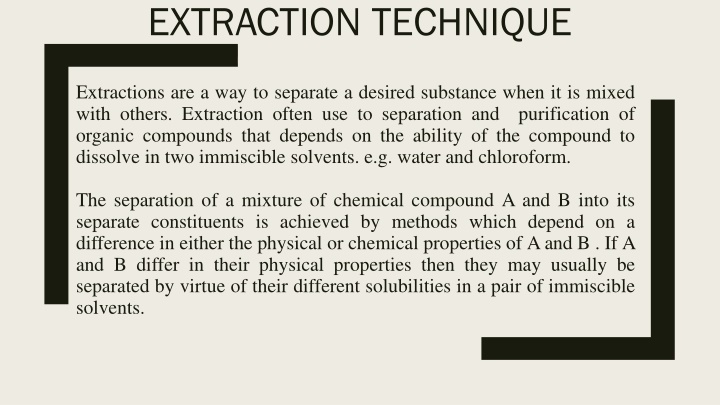
Extraction Techniques for Separating Organic Compounds
Learn about extraction techniques used to separate organic compounds based on differences in solubility in immiscible solvents. Understand how to isolate compounds, remove impurities, and transform mixtures for easy separation. Explore methods like salt formation and reactions to achieve efficient extraction results in organic chemistry laboratories.
Download Presentation

Please find below an Image/Link to download the presentation.
The content on the website is provided AS IS for your information and personal use only. It may not be sold, licensed, or shared on other websites without obtaining consent from the author. If you encounter any issues during the download, it is possible that the publisher has removed the file from their server.
You are allowed to download the files provided on this website for personal or commercial use, subject to the condition that they are used lawfully. All files are the property of their respective owners.
The content on the website is provided AS IS for your information and personal use only. It may not be sold, licensed, or shared on other websites without obtaining consent from the author.
E N D
Presentation Transcript
EXTRACTION TECHNIQUE Extractions are a way to separate a desired substance when it is mixed with others. Extraction often use to separation and organic compounds that depends on the ability of the compound to dissolve in two immiscible solvents. e.g. water and chloroform. purification of The separation of a mixture of chemical compound A and B into its separate constituents is achieved by methods which depend on a difference in either the physical or chemical properties of Aand B . If A and B differ in their physical properties then they may usually be separated by virtue of their different solubilities in a pair of immiscible solvents.
Allow Add equilibrium Solvent 2 Solvent 1+sample Some of the sample Sample become distributed +impurities moves to solvent between 1 and 2
Immiscible solvents are mixtures of liquids that are insoluble in each other. Such solvents will form two layers; the upper layer is for the liquid with the lower density and the lower layer is for the liquid with the higher density. The process of extraction with immiscible solvents is generally employed for the isolation of dissolved compounds from solutions, isolation of solid compounds from mixtures, or removal of undesirable impurities from mixtures (washing). Some times it is used in organic chemistry laboratories to remove an organic compound from a solution when the use of distillation is not convenient.
In many cases mixtures of organic compounds can be separated by methods which depend on a difference in their chemical properties. Frequently. one or more compounds of a mixture is transformed into a salt for easy separation. Salts , in general , are water soluble and insoluble in organic solvents. For example, for acidic compounds(HA): For bases (B):
In this experiment , the mixture may be readily separated by virtue of the fact that p-toluidine will react with HCl in water and 2-naphthol will react with sodium hydroxide (NaOH) in water . Thus, if a solution of a mixture of p-toluidine and 2-naphthol in ether is shaken with aqueous HCl the amine will be removed into the aqueous layer as its ammonium salt , whereas 2-naphthol and the impurities will remain dissolved in the ether .
With only 2-naphthol and impurities left in the ether, the 2-naphthol then can be extracted as its sodium salt by extracting the ether layer with aqueous NaOH. After separation of the aqueous and ether layer , the p-toluidine can be regenerated by basification with aqueous NaOH , while 2-naphthol can be regenerated from its sodium salt by acidification with dilute acid. Note: When performing these exactions, you will have two heterogeneous layers; an organic and an aqueous layer. As a general rule, the organic layer will be the top layer, except for organic solvent with heavy halide groups attached (i.e. CH2Cl2 , CH3CCl3) will be on the bottom layer since they are denser that water.
The organic solvent used for extraction must meet a few criteria 1- Should readily dissolve substance to be extracted. 2-Should not react with the substance to be extracted. 3-Should not react with or be miscible with water (the usual second solvent). 4-Should have a low boiling point so it can be easily removed from the product 5-Inert 6- Not flammable 7- Inexpensive Ether: 1- Low boiling point 2- High solving power 3- Very slightly soluble in water
















